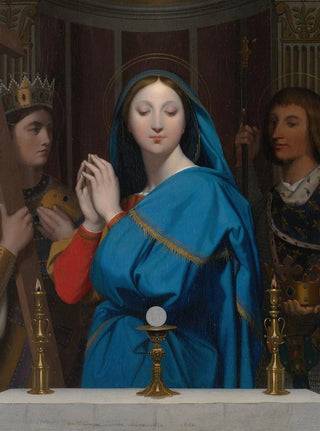Art print | La Vierge adorant l'hostie - Jean-Auguste-Dominique Ingres


View from behind

Frame (optional)
In the fascinating world of art, some works transcend time and space, captivating the mind and awakening the senses. "The Virgin Adoring the Host" by Jean Auguste Dominique Ingres is one of those creations that, through its spiritual depth and formal beauty, invites silent contemplation. Created in the 19th century, this piece stands out for its unique approach to religious representation, where the Virgin Mary, in a posture of devotion, embodies the quintessence of Christian piety. Through this art print, the viewer is drawn into a universe where light, color, and form combine to evoke a sense of wonder and serenity.
Style and uniqueness of the work
Ingres's style is inseparable from his attention to detail and his academic approach. In "The Virgin Adoring the Host," every element is meticulously crafted, from flowing drapery to delicate facial expressions. The composition, both balanced and dynamic, demonstrates an unparalleled mastery of proportions and perspectives. The color palette chosen by the artist, dominated by soft and harmonious tones, creates a soothing atmosphere conducive to meditation. The play of light emphasizes the spirituality of the scene, highlighting the central figure of the Virgin, who seems to radiate divine light. This work also stands out for its treatment of textures, where the softness of the skin contrasts with the richness of the fabrics, thus enhancing the visual and emotional impact of the scene.
The artist and his influence
Jean Auguste Dominique Ingres, an emblematic figure of Neoclassicism, knew how to combine tradition and innovation throughout his career. His training with masters such as Jacques-Louis David profoundly shaped his artistic approach, but it is his ability to infuse his works with sensuality and spirituality that sets him apart. Ingres succeeded in establishing a dialogue between the sacred and the profane, making his religious representations accessible and moving. His influence extends far beyond his era, inspiring generations of artists who saw in him a model of rig

Matte finish

View from behind

Frame (optional)
In the fascinating world of art, some works transcend time and space, captivating the mind and awakening the senses. "The Virgin Adoring the Host" by Jean Auguste Dominique Ingres is one of those creations that, through its spiritual depth and formal beauty, invites silent contemplation. Created in the 19th century, this piece stands out for its unique approach to religious representation, where the Virgin Mary, in a posture of devotion, embodies the quintessence of Christian piety. Through this art print, the viewer is drawn into a universe where light, color, and form combine to evoke a sense of wonder and serenity.
Style and uniqueness of the work
Ingres's style is inseparable from his attention to detail and his academic approach. In "The Virgin Adoring the Host," every element is meticulously crafted, from flowing drapery to delicate facial expressions. The composition, both balanced and dynamic, demonstrates an unparalleled mastery of proportions and perspectives. The color palette chosen by the artist, dominated by soft and harmonious tones, creates a soothing atmosphere conducive to meditation. The play of light emphasizes the spirituality of the scene, highlighting the central figure of the Virgin, who seems to radiate divine light. This work also stands out for its treatment of textures, where the softness of the skin contrasts with the richness of the fabrics, thus enhancing the visual and emotional impact of the scene.
The artist and his influence
Jean Auguste Dominique Ingres, an emblematic figure of Neoclassicism, knew how to combine tradition and innovation throughout his career. His training with masters such as Jacques-Louis David profoundly shaped his artistic approach, but it is his ability to infuse his works with sensuality and spirituality that sets him apart. Ingres succeeded in establishing a dialogue between the sacred and the profane, making his religious representations accessible and moving. His influence extends far beyond his era, inspiring generations of artists who saw in him a model of rig






